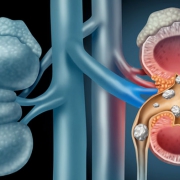Urinary Tract Fistula After Hysterectomy: What are the Options?
Severe continuous leakage of urine is a rare complication after routine hysterectomy. This can be a sign of a fistula between the bladder, vaginal wall, or the ureter and the vaginal wall. A fistula is an abnormal tract that forms between two areas of the body.
Keep reading below to learn more about urinary tract fistula from a Georgia Urology expert.
What are the Symptoms of Urinary Tract Fistula?
The main symptom of a urinary tract fistula to the vagina is nonstop leakage of urine. Associated symptoms include abdominal pain or fever if urine collects in the abdomen. The type of leakage associated with a fistula is more severe than the typical stress and urge incontinence that can also occur. In most cases, it requires surgical intervention to repair this complication.
How is Urinary Tract Fistula Treated?
In the past, women would have to wait 6 weeks to 3 months before repairs could be attempted after a traditional open hysterectomy. This is due to the number of adhesions or scar tissue that forms after surgery. This was especially true because the signs of fistula can be delayed for a week to 10 days as the tract forms and this is when the adhesions start to become difficult. A woman would have to wait either with a catheter, a nephrostomy tube (a tube into the kidney through the back), or deal with the leakage until the repair could be attempted.
Robotic-assisted surgery has changed the urologist’s approach to this life-changing complication. Due to the robotic arms and 10x magnification camera, we are allowed the ability to access the pelvis with great visualization and dexterity. This is done through small incisions as opposed to a large midline incision. Urologists no longer need to wait months to repair the fistula. We can either re-implant the ureter to move it away from the fistula tract in the case of a ureterovaginal fistula or dissect the bladder away from the vaginal wall in the case of a vesicovaginal fistula.
What is Recovery Like for Treating Urinary Tract Fistula?
Since the surgery is minimally invasive, the patient can go home the next day and can be completely healed in about 4 weeks. This significantly shortens the recovery time compared to open repair. An indwelling catheter to drain the bladder and a ureteral stent may be needed postoperatively for a short period of time.
Although initially devasting, the repair of vesicovaginal or ureterovaginal fistula post hysterectomy can be performed in a timely fashion thanks to the robotic approach. Women with this complication can return to their normal life with a smaller incision, less pain and recovery time, and most importantly no further severe leakage of urine.
If you have any more questions about this urological condition or treatment options, get in contact with Georgia Urology physicians by clicking here.









